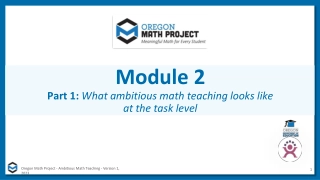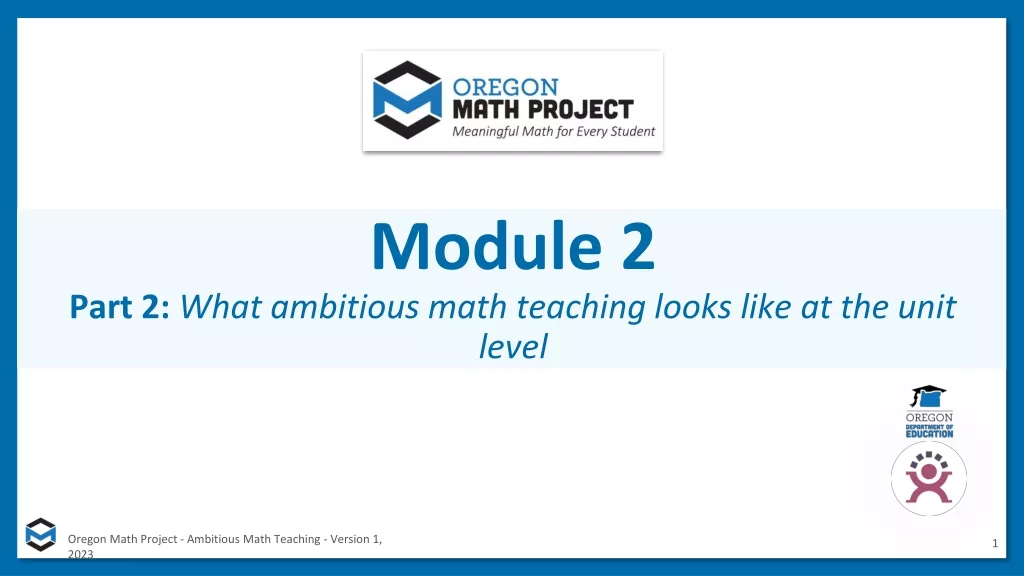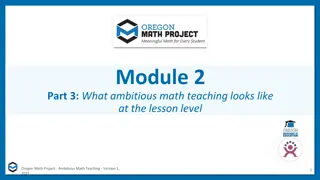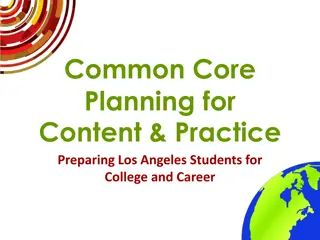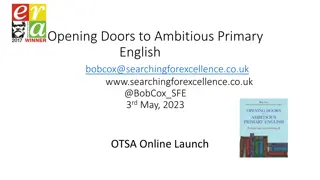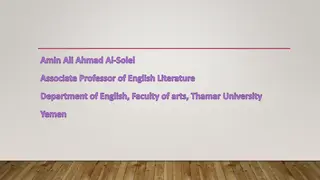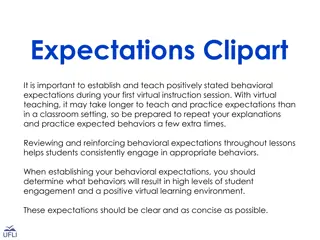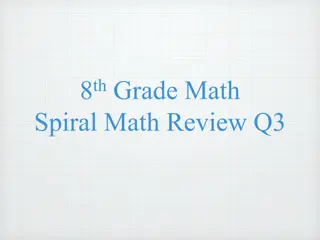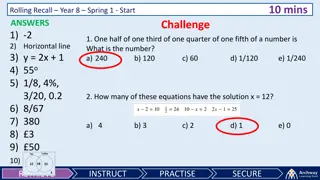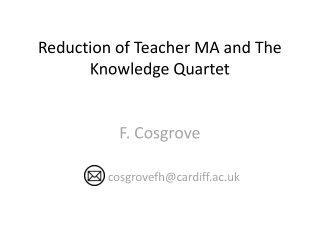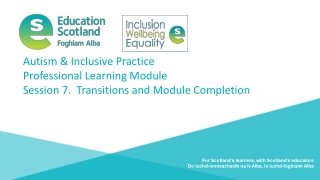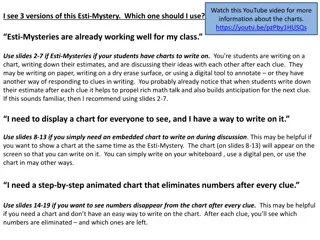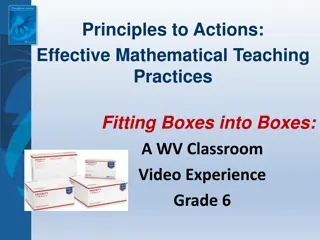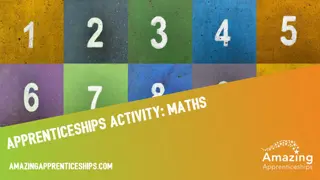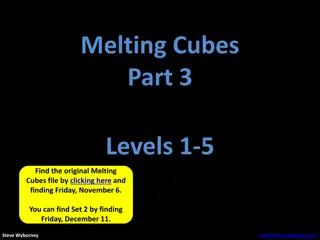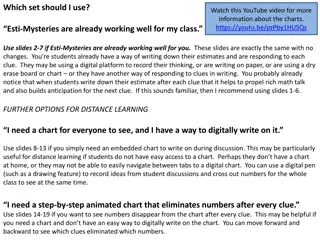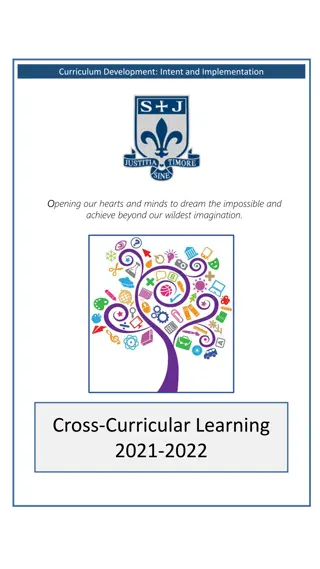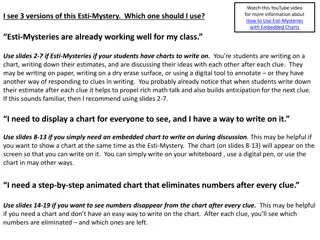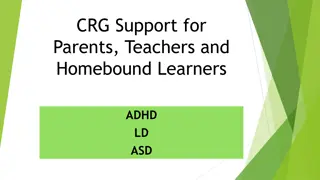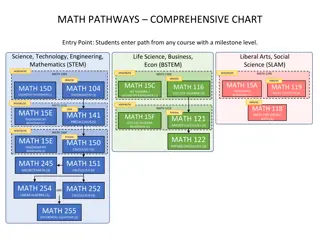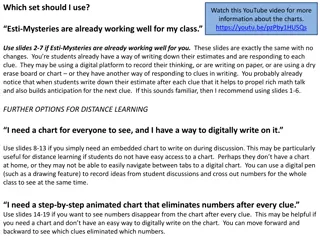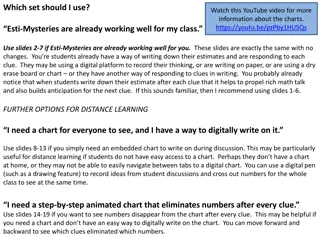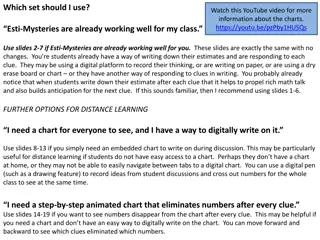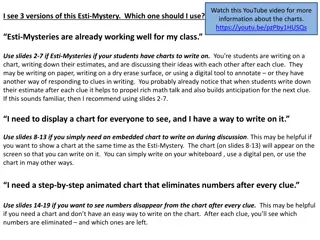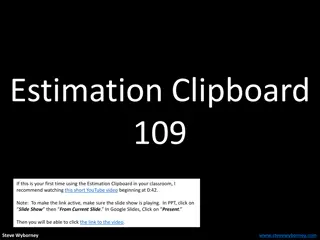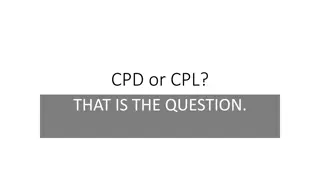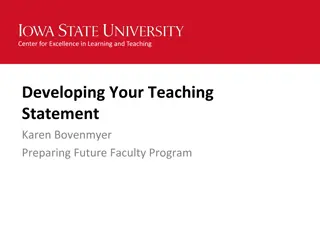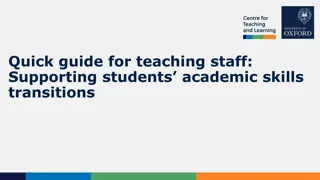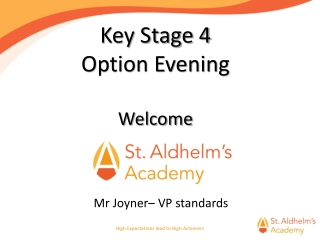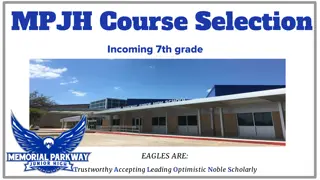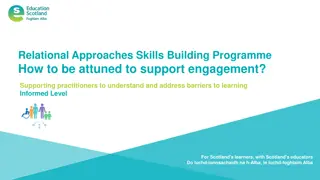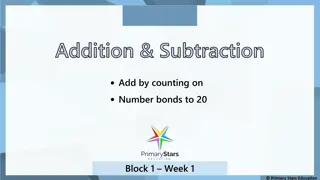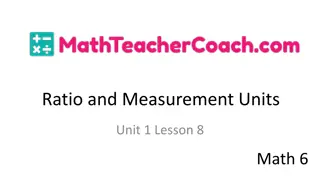Ambitious Math Teaching and Expectations for Students as Learners
Reflect on expectations for students as math learners and explore ambitious math teaching practices. Join the Oregon Math Project to promote equitable math experiences for all students.
Download Presentation

Please find below an Image/Link to download the presentation.
The content on the website is provided AS IS for your information and personal use only. It may not be sold, licensed, or shared on other websites without obtaining consent from the author. Download presentation by click this link. If you encounter any issues during the download, it is possible that the publisher has removed the file from their server.
E N D
Presentation Transcript
Module 1 Part 1: Ambitious math teaching, and our expectations for students as math learners Oregon Math Project - Ambitious Math Teaching - Version 1, 2023 1
Session 1 The focus of this session is to reflect on our expectations for students experiences as math learners. Understanding ambitious math teaching: Our hopes for students as math learners Agenda for this session: 1. Setting and maintaining norms: Developing our norms for interacting together 2. Doing math together: Reflecting on our expectations for students experiences as math learners through a data & statistics task 3. Connecting to research: The importance of building procedural fluency from conceptual understanding in light of our expectations for students experiences as math learners 4. Planning for action: Shifts needed in light of our expectations for students experiences as math learners Time estimate:2 hours M1 P1 Table of Contents 5 Oregon Math Project - Ambitious Math Teaching - Version 1, 2023
Oregon Math Project: Meaningful math for all The Oregon Math Project (OMP) advances mathematics education in our state by cultivating a network of educators that promotes equitable math experiences for all students through guidance and the support of policies, standards, curricula, assessments, and instructional best practices. Realizing the vision of math education in Oregon includes ensuring that all students attain mathematics proficiency by having access to high-quality instruction that includes challenging and coherent content in a learning environment where each student receives the support they need to succeed in mathematics. 6 Oregon Math Project - Ambitious Math Teaching - Version 1, 2023
Essential Questions of the Modules Module 1: Foundations of High School Math Instruction What is ambitious math teaching? Why is a 2 + 1 model important for equitable outcomes in mathematics? Module 2: Principles and Practices of Ambitious Math Teaching What does ambitious math teaching look like at the unit, lesson, and task levels? How do we value and build on the mathematical strengths of students who are often excluded by schooling? What planning, teaching, and assessment practices can be used to sustain ambitious math teaching? Module 3: Principles and Practices of Sustainability 7 Oregon Math Project - Ambitious Math Teaching - Version 1, 2023
Four Cornerstones: Oregon Math Project & Oregon Educational Goals (ORS 329.015) Provide students with the skills necessary to pursue learning throughout their lives in an ever-changing world. (ORS 329.015(2)(a)) Provide an environment that motivates students to have experience in applying knowledge and skills and demonstrating achievement. (ORS 329.015(2)(b)) Equip students with the academic and career skills and information necessary to pursue the future of their choice. (ORS 329.015(2)(a)) Provide an environment that motivates students to pursue serious scholarship. (ORS 329.015(2)(b)) 8 Oregon Math Project - Ambitious Math Teaching - Version 1, 2023
The work of engineering a more equitable math system is centered on four cornerstone principles of the Oregon Math Project: FOCUS, ENGAGEMENT, PATHWAYS, and BELONGING Focus: Learning experiences in every grade and course are focused on core mathematical content and practices that progress purposefully across grade levels. Any proposed instructional approach, curricular change, or system design element should be evaluated by the degree to which it builds on these four cornerstones. When new approaches are built within the framework of all four-cornerstone principles, we will be on our way to engineering a reimagined system. Engagement: Mathematical learning happens in environments that motivate all students to engage with relevant and meaningful issues in the world around them. Pathways: All students are equipped with the mathematical knowledge and skills necessary to identify and productively pursue any postsecondary paths in their future. Students have agency to choose from a variety of courses, contexts, and applications they find relevant. Belonging: Participation in mathematical learning builds students identities as capable math learners and fosters a positive self-concept. Students cultural and linguistic assets are valued in ways that contribute to a sense of belonging to a community of learners. (ODE, 2022) 2022 Oregon Mathematics Standards & Guidance (v5.2.5), p. 5. 9 Oregon Math Project - Ambitious Math Teaching - Version 1, 2023
Across the modules we will have opportunities to Set and maintain norms: These activities support participants to establish norms that will guide participation in sessions. Do math together: These activities engage participants in a mathematics task. Study teaching: These activities involve analysis of video, vignettes, live teaching, or instructional tools. Connect to research: These activities involve unpacking and understanding the research in mathematics education underpinning focal ideas and concepts. Plan for action: These activities involve making links between session content and our own practice and contexts. 10 Oregon Math Project - Ambitious Math Teaching - Version 1, 2023
Setting and maintaining norms Developing our norms for interacting together 11 Oregon Math Project - Ambitious Math Teaching - Version 1, 2023
Developing productive norms for interaction What do you need from your colleagues to maximize your learning as we do math together and reflect on ideas? Examples: I need someone to ask questions when I m stuck - not to just tell me what to do, but to help me figure it out by asking questions about my thinking. No side bars, please. I m easily distracted and need help focusing. 13 Oregon Math Project - Ambitious Math Teaching - Version 1, 2023
Classroom rules reimagined as the rights of the learner Clarifying the classroom rules can be helpful, but some rules imply that certain skills and knowledge are valued more than others What if instead we organized classrooms around ways to value one another s ideas and learning? How can framing rules as the rights of the learner support the development of a productive mathematical community? The rights of the learner: to be confused; to claim a mistake; to speak, listen, and be heard; and to write, do, and represent what makes sense to you. (Kalinec-Craig & Robles, 2020) 14 Oregon Math Project - Ambitious Math Teaching - Version 1, 2023
Small Group Activity Directions: Build a slide with your team norms. 15 Oregon Math Project - Ambitious Math Teaching - Version 1, 2023
Preview of Workspace Slide Team names: What do you need from your colleagues to maximize your learning as we do math together and reflect on ideas? our DRAFT norms 1. Rights of Learners You have the right to be confused make mistakes say what makes sense to you share unfinished or rough draft thinking and not be judged revise your thinking 16 (Jansen, 2020; Kalinec-Craig, 2017) Oregon Math Project - Ambitious Math Teaching - Version 1, 2023
Doing math together: Reflecting on our expectations for students experiences as math learners through a data & statistics task Oregon Math Project - Ambitious Math Teaching - Version 1, 2023 17
Orienting ourselves to the mathematics for this task Related Oregon Math Standards HS.DR.A Formulate statistical investigative questions HS.DR.A.4 Use mathematical and statistical reasoning to formulate questions about data to evaluate conclusions and assess risks. HS.DR.C Analyze, summarize, and describe data HS.DR.C.8 Identify appropriate ways to summarize and then represent the distribution of univariate and bivariate data multiple ways with graphs and/or tables. Use technology to present data that supports interpretation of tabular and graphical representations. Oregon Math Project - Ambitious Math Teaching - Version 1, 2023 19
Thinking critically about using and interpreting data ...Data visualizations are social texts, authored from specific points of view, that narrate particular, and often consequential, stories (Rubel et al., 2021 p.249) What feels true about this quote? What feels challenging? Adapted from: (Rubel et al., 2021) 20 Oregon Math Project - Ambitious Math Teaching - Version 1, 2023
Critical Sensemaking of Data Protocol Reading and Making Sense of Data and Data Visualizations Critically Reading and Making Sense of Data and Data Visualizations What stories could be told? What story is the author telling with this data? Both reading and critically re-reading are crucial to making good sense of data. Which relationships could be highlighted? Which relationship(s) is the author highlighting? What has the author quantified? How has the author defined the measurements? What could be quantified and what would be necessary? How has the author grouped or quantified people or things? What are the equity/justice implications of how people and things have been grouped, categorized or measured? Adapted from: (Rubel et al., 2021) 21 Oregon Math Project - Ambitious Math Teaching - Version 1, 2023
Data preview Private Reasoning Time: Consider the following questions and reflect on how you want your answers to influence the way you notice and wonder about the data: What story is the author telling with this data? What are the data s blind spots? What/whose perspectives are missing? What assumptions about equity, justice and injustice might this data surface? Given your equity commitments, what assumptions might you want to bring to this data? The data in on the handout shows the median annual incomes of different racial groups at different points in history. This prompts for our Data Preview are inspired and adapted by work from the HTH GSE Center for Research on Equity and Innovation. For more protocols visit: https://hthgse.edu/crei/protocols 22 Oregon Math Project - Ambitious Math Teaching - Version 1, 2023
What do you notice? What do you wonder? I notice... I wonder... Original lesson resource: Lesson 6.3: Culturally Relevant Income Inequality (Berry et al., 2020; Reardon, 2020) 23 Oregon Math Project - Ambitious Math Teaching - Version 1, 2023
Small Group Activity Directions: Record your team s noticings and wonderings about the data. 24 Oregon Math Project - Ambitious Math Teaching - Version 1, 2023
Preview of Workspace Slide What do you notice? What do you wonder? I notice... I wonder... Original lesson resource: Lesson 6.3: Culturally Relevant Income Inequality (Berry et al., 2020; Reardon, 2020) 25 Oregon Math Project - Ambitious Math Teaching - Version 1, 2023
STUDENT WORK What makes sense in each student s reasoning and why? Who do you agree with and why? Determine whether the income gap between white and Black people is increasing, decreasing or staying the same. Student A said that the gap in median income between white and Black people is decreasing because Black median income increased 74% between 1967 and 2014 and white median income only increased 59%. Student B said that the gap in median income between white and Black people is increasing because the white median income gains more each year. 26 Oregon Math Project - Ambitious Math Teaching - Version 1, 2023
Small Group Activity Directions: Record what makes sense about each student s reasoning. 27 Oregon Math Project - Ambitious Math Teaching - Version 1, 2023
Preview of Workspace Slide STUDENT WORK What makes sense in each student s reasoning and why? Who do you agree with and why? Determine whether the income gap between white and Black people is increasing, decreasing or staying the same. What makes sense in Student A s reasoning is Because Student A said that the gap in median income between white and Black people is decreasing because Black median income increased 74% between 1967 and 2014 and white median income only increased 59%. 28 Oregon Math Project - Ambitious Math Teaching - Version 1, 2023
Preview of Workspace Slide STUDENT WORK What makes sense in each student s reasoning and why? Who do you agree with and why? Determine whether the income gap between white and Black people is increasing, decreasing or staying the same. What makes sense in Student B s reasoning is Because Student B said that the gap in median income between white and Black people is increasing because the white median income gains more each year. 29 Oregon Math Project - Ambitious Math Teaching - Version 1, 2023
Reflecting on the mathematics 4L: HS Data & Statistics Standards and Guidance Critical Areas of Focus Decisions or predictions are often based on data numbers in context. These decisions or predictions would be easy to make if the data always sent a clear message, but the message is often obscured by variability. Statistics provides tools for describing variability in data and for making informed decisions that take it into account. What do you want to remember when you are comparing and analyzing data? How did this lesson help you think about what you might do as a citizen moving forward when you encounter data or claims about growth? (ODE, 2022) 30 Oregon Math Project - Ambitious Math Teaching - Version 1, 2023
Debriefing the data & statistics task: Goals for us as math learners: Mathematical goal: Deepen our understanding of data analysis techniques for contextual situations Equity goal: Build a community of learners where participants listen to each other and are ready to respond to what they have heard 1. 2. 3. How did you see me working on each of these goals during the lesson? What moves was I making as a teacher of mathematics? What moves could have been made to support our work on these goals even more? 31 Oregon Math Project - Ambitious Math Teaching - Version 1, 2023
Debriefing the data & statistics task: Goals for us as teachers: Equity goal: Surface the importance of changing the way we teach to reach diverse students by giving access Pedagogical goal: Look for and express regularity through analysis, critique and debate of student work What expectations do you have for students experiences as math learners? What questions are emerging for you? 32 Oregon Math Project - Ambitious Math Teaching - Version 1, 2023
Reflecting on our expectatons for students experiences as math learners As students see themselves as doers of mathematics, they build confidence and develop mathematical agency and authority. From Continuing the Journey: Mathematics Learning 2021 and Beyond by NCTM, NCSM, & ASSM What do you want to hold onto as we move forward, as expectations for students experiences as math learners? How did this lesson help you think about your expectations for students experiences? (ASSM, NCSM, & NCTM, 2021) 33 Oregon Math Project - Ambitious Math Teaching - Version 1, 2023
Debrief: Practices of ambitious mathematics teaching Which of these 8 practices did you notice? What others could have been highlighted? In what ways? 1. Establish mathematical goals to focus learning 2. Implement tasks that promote reasoning and problem solving 3. Use and connect mathematical representations 4. Facilitate meaningful mathematical discourse 5. Pose purposeful questions 6. Build on procedural fluency from conceptual understanding 7. Support productive struggle in learning mathematics 8. Elicit and use evidence of student thinking v (NCTM, 2014) 34 Oregon Math Project - Ambitious Math Teaching - Version 1, 2023
Connecting to research The importance of building procedural fluency from conceptual understanding in light of our expectations for students experiences as math learners Oregon Math Project - Ambitious Math Teaching - Version 1, 2023 35
Reading: Conceptual Understanding Procedural Fluency Directions Read Building Procedural Fluency from Conceptual Understanding Be prepared to discuss the following reflection questions: How is the definition of procedural fluency in the reading the same/different from your your thoughts prior to reading the article? How does developing conceptual understanding help build procedural fluency? What are some specific examples of this? What are some implications for your practice, as a leader and as a teacher? We will start back at _____________ (NCTM, 2014) 37 Oregon Math Project - Ambitious Math Teaching - Version 1, 2023
Defining conceptual understanding & procedural fluency Conceptual understanding Procedural fluency Focuses on explaining why processes work & when it is appropriate to use Refers to understanding the meaning. Reasoning why a negative times a negative will always yield a positive number. Focuses on how to perform a process. Refers to knowing the process Knowing that multiplying two negative numbers yields a positive number. (NCTM, 2014) 38 Oregon Math Project - Ambitious Math Teaching - Version 1, 2023
Mathematical Teaching Practices Continuum What does conceptual understanding look like in practice? Teacher Centered > Making Progress > Student Centered Build Procedural Fluency from Conceptual Understanding Teacher s questions probe reasoning about mathematical relationships, mathematical representations, and why solutions make sense. Teacher asks for explanations of procedures, application of rules, or use of definitions. The teacher guides students toward one strategy. Teachers ask for justification of conjectures and encourage students to question and to extend their own thinking to make new connections. Questions build on what students start but tend to channel students thinking toward a preferred strategy or method of solution. The teacher guides the whole class in developing reasoning and justification for correct solutions. Students look only to teacher or the text to validate mathematical correctness. The teacher entertains alternative methods and solutions as long as students can justify their reasoning. (NCSM, 2019, p. 56) 39 Oregon Math Project - Ambitious Math Teaching - Version 1, 2023
Planning for action Shifts needed in light of our hopes for students experiences as math learners Oregon Math Project - Ambitious Math Teaching - Version 1, 2023 40
Reflecting on shifts needed Respond to these prompts independently, then share with a partner / your group. In light of the expectations we have for students as math learners: I want to shift away from I want to shift toward What shifts would you like to see in math education in the next 10 years? Why? Oregon Math Project - Ambitious Math Teaching - Version 1, 2023 42
Debriefing Session 1 Reflecting on our work in the activities in the session 43 Oregon Math Project - Ambitious Math Teaching - Version 1, 2023
Debriefing Session 1: Four cornerstone principles of the OMP What connections do you see between any of the cornerstones and our work in this session? Focus: Learning experiences in every grade and course are focused on core mathematical content and practices that progress purposefully across grade levels. Any proposed instructional approach, curricular change, or system design element should be evaluated by the degree to which it builds on these four cornerstones. When new approaches are built within the framework of all four-cornerstone principles, we will be on our way to engineering a reimagined system. Engagement: Mathematical learning happens in environments that motivate all students to engage with relevant and meaningful issues in the world around them. v Pathways: All students are equipped with the mathematical knowledge and skills necessary to identify and productively pursue any postsecondary paths in their future. Students have agency to choose from a variety of courses, contexts, and applications they find relevant. Belonging: Participation in mathematical learning builds students identities as capable math learners and fosters a positive self-concept. Students cultural and linguistic assets are valued in ways that contribute to a sense of belonging to a community of learners. (ODE, 2022) 44 Oregon Math Project - Ambitious Math Teaching - Version 1, 2023
Debriefing Session 1: Focus of the session What new insights do you have related to our session focus, to reflect on our hopes for students experiences as math learners? Take a couple of minutes to reflect on our work in the session. Agenda for this session: 1. Setting and maintaining norms: Developing our norms for interacting together 2. Doing math together: Reflecting on our hopes for students experiences as math learners through a data & statistics task 3. Connecting to research: The importance of building procedural fluency from conceptual understanding in light of our hopes for students experiences as math learners 4. Planning for action: Shifts needed in light of our hopes for students experiences as math learners v 45 Oregon Math Project - Ambitious Math Teaching - Version 1, 2023
Session 2 The focus of this session is to clarify the principles and practices guiding our work. Understanding ambitious math teaching: Principles and practices of ambitious math teaching Agenda for this session: 1. Setting and maintaining norms: Reconnect with and revise our norms for interacting together 2. Connecting to research: The principles and practices of ambitious math teaching 3. Connecting to research: What does research say about ambitious math teaching? 4. Planning for action: Noticing and amplifying principles and practices of ambitious math teaching in a math task Time estimate:1 hour, 45 minutes M1 P1 Table of Contents 46 Oregon Math Project - Ambitious Math Teaching - Version 1, 2023
Setting and maintaining norms Revisit and revise our norms for interacting together Oregon Math Project - Ambitious Math Teaching - Version 1, 2023 47
Revisiting norms [Insert your group norms] Rights of a Learner You have the right to: Be confused Make mistakes Say what makes sense to you Share unfinished or rough draft thinking and not be judged (Kalinec-Craig, 2017) Oregon Math Project - Ambitious Math Teaching - Version 1, 2023 49
Connecting to research: The principles and practices of ambitious math teaching Oregon Math Project - Ambitious Math Teaching - Version 1, 2023 50
As we begin our exploration of ambitious math teaching: This is an opportunity for us all to continue to reflect on our current practices and beliefs and identify shifts we want to make. I want to shift away from I want to shift toward 52 Oregon Math Project - Ambitious Math Teaching - Version 1, 2023
Principles of ambitious math teaching Ambitious teaching: Engages students in making sense of mathematical concepts Centers students thinking and reasoning through discourse Views students as capable of using their understandings and assets to solve authentic problems Values students thinking, including emergent understanding and errors Attends to student thinking in an equitable and responsive manner Ambitious teaching is teaching that deliberately aims for all students across ethnic, racial, class, and gender categories not only to acquire, but also to understand and use knowledge, and to use it to solve authentic problems. (Lampert & Graziani, 2009, p. 492) Oregon Math Project - Ambitious Math Teaching - Version 1, 2023 53
Shifting from traditional discourse to ambitious and equitable discourse Teacher asks What answer did you get? traditional discourse ambitious and equitable discourse (Horn & Garner, 2022) Oregon Math Project - Ambitious Math Teaching - Version 1, 2023 54
Shifting from traditional participation to ambitious and equitable participation status strongly influences student participation student participation is broadened by fostering equal-student interactions (Horn & Garner, 2022) Oregon Math Project - Ambitious Math Teaching - Version 1, 2023 55
Small Group Activity Directions: Use post-it notes to begin to fill out a trajectory that shifts from traditional to ambitious and equitable discourse and from traditional to ambitious and equitable participation 56 Oregon Math Project - Ambitious Math Teaching - Version 1, 2023
Shifting from traditional discourse to ambitious and equitable discourse Teacher asks What answer did you get? traditional discourse ambitious and equitable discourse (Horn & Garner, 2022) Oregon Math Project - Ambitious Math Teaching - Version 1, 2023 57
Shifting from traditional participation to ambitious and equitable participation status strongly influences student participation student participation is broadened by fostering equal-student interactions (Horn & Garner, 2022) Oregon Math Project - Ambitious Math Teaching - Version 1, 2023 58
Practices of ambitious mathematics teaching The National Council of Teachers of Mathematics describes a set of eight teaching practices that serve as a foundation for ambitious teaching: 1. Establish mathematical goals to focus learning 2. Implement tasks that promote reasoning and problem solving 3. Use and connect mathematical representations 4. Facilitate meaningful mathematical discourse 5. Pose purposeful questions 6. Build on procedural fluency from conceptual understanding 7. Support productive struggle in learning mathematics 8. Elicit and use evidence of student thinking v (NCTM, 2014) 59 Oregon Math Project - Ambitious Math Teaching - Version 1, 2023


